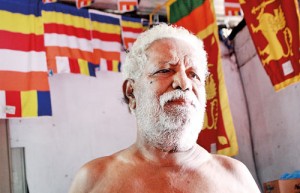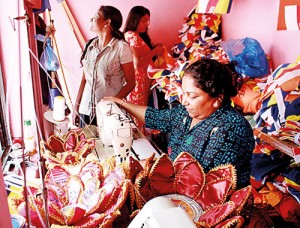Where faith flutters high
Walk into ‘Deepaduttara’ on Baseline Road, Dematagoda, and what greets the eye is a group of five women seated in front of their sewing machines totally absorbed in their work. They only pause when a customer enters looking for a bulk of Bauddha kodi.
Vesak flags that represent the Buddhist faith are seen everywhere during Vesak celebrations. In preparation for this time, Deepika Hemamali, the owner of Deepaduttara and her assistants take to working with great dedication- sometimes till midnight to meet the demands of the bulk buyers, even those from outstation and abroad who have placed orders for flags.

Hemapala: Getting ready to hoist the biggest flag for the seventh consecutive year
Named after the temple Deepaduththararamaya in Kotahena, one of the sites where the first Buddhist flag was hoisted, Deepika has been running this shop for the past 25 years with the support of her father K. Hemapala and her brothers.
They sew Buddhist flags for the Vesak and Poson season to meet the demand. “We keep a set of Buddhist flags throughout the year as there is a demand for them from temples during the Katina season and during Peraheras.” In February, they focus on stitching National flags for Independence Day celebrations, Deepika says.
As the income so generated is not sufficient, they also stitch other items required for poojas and pinkam in the temples- pawada, muthu kuda, and the lotus on which relics are kept or Buddha poojawa is offered, says Deepika showing us a shimmering sequin-studded lotus made of cloth.
Lamenting that business has not been that great this time as Vesak is falling soon after Avurudu, Deepika says that last year they stitched about 20,000 Buddhist flags of various sizes. “Starting from smaller sizes, we create Buddhist flags up to about 10 feet long. We also create palam kodi, these are the type of flags, which are hoisted across the road and they are about 40 feet long,” she explains adding that a few days ago she had a group of Sri Lankans from Italy who came to her shop to purchase Buddhist flags to take back to Italy for Vesak celebrations.

Flags and more flags: Deepika and her band of women at work. Pix by Athula Devapriya
“Whenever I see a Buddhist flag fluttering somewhere, my mind fills with contentment. Also it is an equally nice feeling when we have customers from all religions visiting our shop to purchase Buddhist flags for Vesak,” Deepika says.
As Deepika narrated her story, we heard the sound of machine wheels next door. “It is my father Hemapala’s workshop- he is famous for putting up the biggest Buddha flag for Vesak every year,” said Deepika.
Her father K. Hemapala, proudly tells us the flag he put up is 50 ft wide and 140 ft long. This is the seventh consecutive year that Hemapala is hoisting it with the assistance of the Maga Engineering Group Chairman M.G. Kularatne who has undertaken to sponsor the steel frame.
“I am stitching a new flag this year as one flag can be used twice only,” he says.
| Beginnings of the Buddhist flag The Buddhist Flag was first hoisted on Vesak Full Moon Day in 1885. The historical background which led to the creation of the Buddhist flag was a request made to the British rulers by a Buddhist Defence Committee to declare Vesak Poya as a public holiday, according to the souvenir Dajobasa compiled by Ven. Haegoda Vipassa Thera in commemoration of the 125th Anniversary of the declaration of Vesak Poya and designing of the Buddhist flag. The souvenir states that the Defence Committee was established by Ven. Hikkaduwe Sri Sumangala Thera who convened a meeting with Col. Henry Steele Olcott and several leading Buddhist figures at Vidyodaya Pirivena in 1884 to initiate a Buddhist revival against the British government’s efforts to suppress Buddhism. Accordingly, a communiqué sent by the committee to British Imperial Secretary Lord Derby through Col. Olcott included a request to have Vesak Poya declared as a public holiday. Approval being granted, this led to celebrations being organised on a grand scale to mark Vesak Poya and the Buddhist Defence Committee felt there was a need to get a Buddhist flag designed. As to who designed the flag has not been clearly established with some attributing it to Col. Olcott. Places where the original Buddhist flag was hoisted had been identified as Deepaduththararamaya in Kotahena, Vidyodaya Pirivena Colombo, Kelaniya Raja Maha Viharaya, Colombo Buddhist Theosophical Society and Hunupitiya Gangaramaya. The colours of the Buddhist flag nila (blue), pita (yellow), lohitha (crimson), odatha (white), manjista (tawny) and Prabahashwara (the mixture of these colours) represent the rays of splendour and lustre said to have been emanating from the body of Lord Buddha. On a proposal made by Prof. G.P. Malalasekara at the inaugural meeting of the World Fellowship of Buddhists held in Kandy in 1950, it was unanimously accepted as the international Buddhist flag. |


